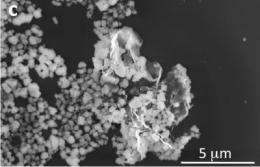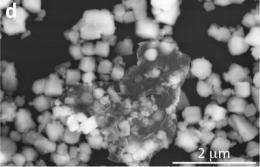New fracture resistance mechanisms provided by graphene

A team of researchers from the University of Arizona and Rensselaer Polytechnic Institute have increased the toughness of ceramic composites by using graphene reinforcements that enable new fracture resistance mechanisms in the ceramic.
The research, lead by Assistant Professor Erica L. Corral from the Materials Science and Engineering Department at the University of Arizona in Tucson, and Professor Nikhil Koratkar from the Department of Mechanical, Aerospace and Nuclear Engineering at Rensselaer Polytechnic Institute in Troy, New York, was recently published in ACS Nano, the monthly journal of the American Chemical Society.
"Our work on graphene ceramic composites is the first of its kind in the open literature and shows mechanisms for toughening using two-dimensional graphene sheets that have yet to be seen in ceramic composites," said Corral. "We have significantly increased the toughness of a ceramic and made the first observations of graphene that arrest crack propagation and force the crack to change directions in not just two but also three dimensions."
These observations will lead to a new approach for composite design using graphene in ceramics that has not been possible using conventional fiber reinforcements, says Corral. "The high surface area and unique two-dimensional sheet geometry seem to be better at arresting crack growth in ceramics over conventional fibers that are one-dimensional reinforcements," she said.
"This is a classic example of highly successful interdisciplinary research across universities that was unheard of 15 or 20 years ago, but is now becoming critically important if we are to continue to make breakthrough discoveries and maintain the competiveness of the United States in the 21st century," said Prof. Koratkar of the Rensselaer Polytechnic Institute. Koratkar met Dr. Corral at a National Science Foundation-sponsored nanoscience conference where she delivered a talk on her work in carbon nanotube ceramic composites.

Koratkar was impressed with Corral's presentation, and approached her regarding the possibility of exploring the use of graphene to increase toughening in brittle ceramics. "Over the next year we leveraged my lab's expertise in the synthesis of bulk quantities of graphene platelets and the expertise of Corral's group in ceramic composite fabrication and testing," Koratkar said. "Our results published in ACS Nano show the tremendous promise that graphene shows in toughening ceramics that are notoriously brittle and prone to failure. This work could open up an entirely new graphene ceramic nanocomposites field of study," he says.
This is the first published work describing the use of graphene nanofiller to reinforce ceramics and will appear in the journal ACS Nano. This discovery -- measured to increase fracture resistance of the resulting ceramic nanocomposite by over 200 percent -- could potentially be used to enhance toughness for a range of ceramic materials, enabling their widespread use in high-performance, structural applications that require operating temperatures greater than 1,000 degrees Celsius while maintaining structural integrity.
More information: pubs.acs.org/doi/abs/10.1021/nn200319d
Provided by University of Arizona College of Engineering















